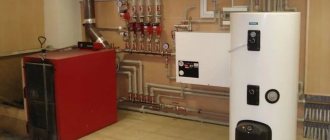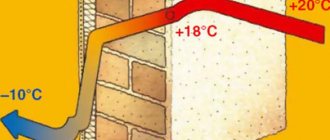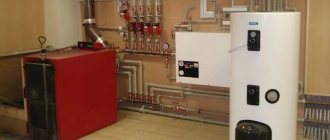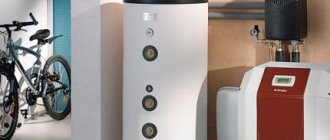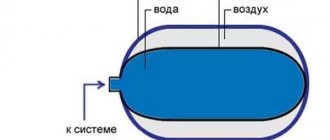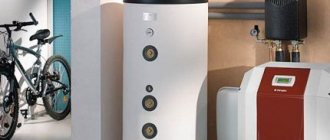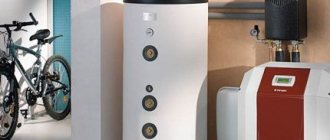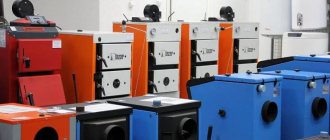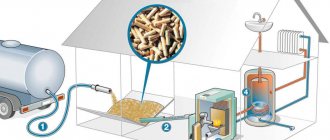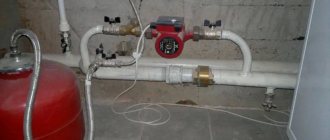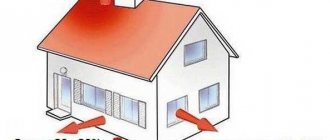Calculating the heating of a private house is one of the important tasks during its construction or major repairs. It is better to do this at the planning stage. A special online calculator can provide some assistance in calculations. There are many calculators for calculating fuel consumption, furnace power, ventilation system, chimney cross-section, productivity of the “warm floor” pumping and mixing unit and others. However, it should be taken into account that all of them show only an approximate result, because can only calculate the simplest configurations. In fact, when calculating heating, it is necessary to take into account a lot of additional nuances. This must be done in order to correctly calculate the costs of the entire heating system and in the future not to suffer from cold in the house or, conversely, its excess, and therefore unnecessary fuel costs.
For help in calculating heating systems, we turned to Akvahit, a company that specializes in installing heating systems in private homes.
When choosing a boiler for heating a house, you need to take into account all the parameters: both the heating equipment and the residential building Source baraholka.com.ru
Calculation of heating in a private house - what needs to be calculated
To calculate the heating of a private home, you need to calculate the power of the heating boiler, decide on the number and placement of radiators, and take into account a number of factors from the weather to thermal insulation and the material used to make the pipes and boiler.
Keep in mind that the comfort of living in the house will depend on this process, since your calculations will directly affect the quality of heating. In addition, these calculations are the basis of the budget for the installation and further operation of the entire heating system. It is at this stage that you will have to decide how much money you will spend on heating your home in the future. When starting calculations, it is important to remember the climatic conditions in which your region is located and the conditions in which the house will be used.
Video description
In our video we’ll talk about heating in a private country house.
Our guest is the author and presenter of the Teplo-Voda channel Vladimir Sukhorukov: The heating system is not only a stove and radiators. It includes:
- Boiler;
- Pumping station;
- Pipes;
- Radiators;
- Control devices;
- Sometimes an expansion tank is needed.
This is roughly what the diagram of a house heating system looks like Source lucheeotoplenie.ru
Calculation of the power of heating devices
Before calculating the power of a heating boiler, you should determine what type of boiler will be used. Heating boilers have different efficiencies and not only the level of heat transfer will depend on this choice, but also the financial component of subsequent operation when choosing fuel:
- Electric boilers,
- Gas boilers,
- Solid fuel boilers,
- Liquid fuel boilers,
- Combined electric/solid fuel boiler.
When the choice of boiler type is made, it is necessary to determine its throughput. The functioning of the entire system will depend on this. The power of a water heating boiler is calculated taking into account the amount of heat energy required per m3. The calculator can help calculate the volume of heated rooms:
- bedroom: 9 m2 3 m = 27 m3,
- bedroom: 12 m2 3 m = 36 m3,
- bedroom: 15 m2 3 m = 45 m3,
- living room: 25 m2 3 m = 75 m3,
- corridor: 6 m2 3 m = 18 m3,
- kitchen: 12 m2 3 m = 36 m3,
- bathroom: 8 m2 3 m = 24 m3.
When calculating, all rooms of the house are taken into account, even if it is not planned to install radiators in them Source stroikairemont.com
See also: Catalog of companies that specialize in insulating houses.
Next, the results are summed up, and the total volume of the house is obtained - 261 m3. When calculating, be sure to take into account rooms and passages in which it is not planned to install heating devices, for example, a corridor, pantry, or hallway. This is done so that the heat from the radiators installed in the house is enough to heat the entire house.
When calculating the heating system, be sure to take into account the climate zone and the outside temperature in winter.
Let's take an arbitrary indicator for the region of 50 W/m3 and a house area of 261 m3, which is planned to be heated. Power calculation formula: 50 W 261 m3 = 13050 W. The result is multiplied by a factor of 1.2 and the boiler power is calculated - 15.6 kW. The coefficient allows you to add 20% of reserve power to the boiler. It will enable the boiler to operate in a saving mode, avoiding special overloads.
Additional temperature sensors will help control the process Source dopebi.ru.net
The correction of the coefficient for the climatic conditions of the regions varies from 0.7 in the southern regions of Russia to 2.0 in the northern regions. A coefficient of 1.2 is used in the central part of Russia.
Here is another formula that online calculators use:
To get a preliminary result of the required boiler power, you can multiply the area of the room by the climate coefficient and divide the resulting result by 10.
An example of a formula for calculating the power of a heating boiler for a house with an area of 120 m2 in the northern region of Russia:
Nk=120*2.0/10=24 kW
Heating a house with a gas holder
It is better to calculate the required amount of gas in relation to the barrel. That is, how long will each container last for different room sizes?
The gas tank is selected according to the number of refills. The optimal rate is 1-2 times a year. At a minimum, the tank should last for 7–8 months—the heating season.
Liquefied gas consumption per season
According to SP 131.13330.2012 Construction Climatology (updated edition of SNiP 23-01-99), the heating season in Russia is 207 days. This is approximately 7 months.
Also important information: the boiler does not operate around the clock. On average, heating operates 10 hours a day.
We carried out calculations based on the initial data:
- brick house without attic and basement;
- floor height 3.2 m;
- The efficiency of the gas boiler is 92%.
Indicators for refueling frequency are averaged. We assumed the same fuel costs for each month. In reality, residence may be seasonal or temporary, and consumption differs depending on the season.
The ratio of the area of the house and the volume of the gas tank (GG)
| GG volume (m3) | Full gas charge (l) | How long will gas last (months) | |||||||
| 50–100 m2 | 150 m2 | 200 m2 | 250 m2 | 300 m2 | 350–450 m2 | 500–600 m2 | 800 m2 | ||
| 3,802 l/year | 5,703 l/year | 7,603 l/year | 9,504 l/year | 11,405 l/year | 17,107 l/year | 22,809 l/year | 30,412 l/year | ||
| 2.5 | 2 125 | 6.7 | 4.5 | 3 | 2.7 | 2 | 1.5 | 1.1 | 0.8 |
| 2.7 | 2 295 | 7 | 5 | 3.6 | 3 | 2.4 | 1.6 | 1.2 | 0.9 |
| 4.6 | 3 910 | 12 | 8 | 6 | 5 | 4 | 2.7 | 2 | 1.5 |
| 4.8 | 4 080 | 12.8 | 8.5 | 6.4 | 5.1 | 4.2 | 2.8 | 2.1 | 1.6 |
| 4.85 | 4 112 | 13 | 8.6 | 6.5 | 5.2 | 4.3 | 2.9 | 2.2 | 1.6 |
| 5 | 4 250 | 13.4 | 9 | 7 | 5.4 | 4.5 | 3 | 2.2 | 1.7 |
| 6.4 | 5 440 | 17 | 11.4 | 8.5 | 6.8 | 5.7 | 3.8 | 2.8 | 2.1 |
| 6.5 | 5 525 | 17.4 | 11.6 | 8.7 | 6.9 | 5.8 | 3.9 | 2.9 | 2.2 |
| 6.6 | 5 610 | 17.6 | 12 | 9 | 7 | 6 | 4 | 3 | 2.2 |
| 8.6 | 7 310 | 23 | 15 | 11.5 | 9 | 7.7 | 5 | 3.8 | 2.9 |
| 9.1 | 7 735 | 24.4 | 16 | 12 | 9.7 | 8 | 5.4 | 4 | 3 |
| 9.15 | 7 777 | 24.5 | 16.4 | 12.3 | 9.8 | 8.2 | 5.5 | 4.1 | 3.1 |
| 9.6 | 8 160 | 25.7 | 17 | 13 | 10 | 8.6 | 5.7 | 4.3 | 3.2 |
| 10 | 8 500 | 27 | 18 | 13.4 | 10.7 | 9 | 6 | 4.5 | 3.4 |
Interpretation of colors in the table:
| irrational | Capacity supply is too large or too small |
| optimal | For seasonal or permanent residence with 2 refills per year |
| perfect | It is best to install for the heating season |
| with reserve | One-time refill is enough for a year |
Houses with an area of 800–1000 m2 are served by:
- gas tanks with industrial volumes of more than 10 m3 (installation is more complicated);
- two containers located side by side (8.6, 9.1 or 9.15 m3).
Which pipes are better for the heating main?
It’s not enough to know how to calculate the boiler’s power; you also need to choose the right pipes. Now the market offers several types of heating pipes made of different materials:
- polyethylene,
- polypropylene (with and without reinforcement),
- steel,
- copper,
- stainless steel
You can take different pipes for heating in a house, but it is important to check the features of the chosen type Source ms.decorexpro.com
Each of these types has its own nuances that should be taken into account when developing and calculating the heating of a private house:
- Steel pipes are universal in use and can withstand pressures of up to 25 atmospheres, but they have a significant drawback - they rust and have a certain service life. In addition, they have difficulties during installation.
- Pipes made of polypropylene, composite metal-plastic and cross-linked polyethylene are easy to install and, due to their weight, can be used on thin walls. The advantage of such pipes is that they are not susceptible to rust, rot and do not react to bacteria. An important indicator is that they do not expand from heat and do not deform in the cold. Withstands constant temperatures up to 90 degrees and short-term increases up to 110 degrees Celsius.
- Copper pipes are distinguished by their high price and increased complexity during installation, but in terms of strength they compete with plastic pipes, are not susceptible to rust and are considered the best option. In addition, copper is ductile, conducts heat well and keeps the temperature of water in pipes ranging from –200 to 250 degrees Celsius. This ability of copper will protect the system from possible defrosting, which is very important in the conditions of Siberia and the northern regions.
If the house is located in the north of the country, then copper pipes for the heating system are best suited Source svizzeraenergia.ch
Real gas consumption: reviews from gas tank owners
We have selected examples of using autonomous heating on the ForumHouse forum. Owners have different experiences. In the project, the insulation of the house, the climate, the needs of the residents and the quality of the boiler are important.
Case 1. The user actively spends LPG - permanent residence with regular showers. A 2,300 liter refill lasts for almost 2 years at a room temperature of at least 21°C. Costs are reduced by using the fireplace 6 times a month - 3 hours of burning and 9 hours of smoldering.
Consumption per year: 20,700 rubles (1150 l at 18 rubles/l). House 125 m2.
Quote from user +Egoza from the ForumHouse forum
Case 2. The user has well insulated the house and installed a low-temperature boiler. In winter I did not take away the hot water supply. Daytime temperature in the rooms is 23°C, night temperature is 20°C. Daily gas consumption is from 6 to 12 liters.
Consumption per year: 15,000 rubles (1000 l at 15 rubles/l). House 120 m2.
Quote from user Khozain2000 from the ForumHouse forum
Case 3. The user heats the house and garage. There are problems with insulation: heat loss through the door, floor and ceiling. Gas consumption is about 15 liters per day. Daytime temperature in the rooms is 22°C, night temperature is 19°C.
Consumption per year: 81,000 rubles (5,475 liters at 15 rubles/l). House and garage 165 m2.
Quote from user AntonVT from the ForumHouse forum
Quote from user AntonVT from the ForumHouse forum
Case 4. The user lives at his dacha on weekends. Only the first floor of the two is heated. On weekdays, if there are no residents, the temperature is automatically maintained at 7°C. The hot water supply has not yet been started. Uses remote heating control via a ZONT room thermostat with its own SIM card.
Consumption per year: 33,900 rubles (2,275 liters for 14.90 rubles/l). House 190 m2.
Quote from user Dimabol from the ForumHouse forum
How to calculate the optimal number and volumes of heat exchangers
When calculating the number of radiators required, you should take into account what material they are made from. The market now offers three types of metal radiators:
- Cast iron,
- Aluminum,
- Bimetallic alloy,
They all have their own characteristics. Cast iron and aluminum have the same heat transfer rate, but aluminum cools quickly, while cast iron heats up slowly but retains heat for a long time. Bimetallic radiators heat up quickly, but cool down much more slowly than aluminum ones.
When calculating the number of radiators, other nuances should also be taken into account:
- thermal insulation of floors and walls helps retain up to 35% of heat,
- the corner room is cooler than others and requires more radiators,
- the use of double-glazed windows on windows saves 15% of heat energy,
- Up to 25% of the heat energy “escapes” through the roof.
The number of heating radiators and sections in them depends on many factors Source amikta.ru
In accordance with SNiP standards, heating 1 m³ requires 100 W of heat. Therefore, 50 m³ will require 5000 W. On average, one section of a bimetallic radiator emits 150 W at a coolant temperature of 50 °C, and a device for 8 sections emits 150 * 8 = 1200 W. Using a simple calculator we calculate: 5000: 1200 = 4.16. That is, to heat this area you need about 4-5 radiators.
However, in a private house the temperature is regulated independently and it is usually believed that one battery emits 1500-1800 W of heat. We recalculate the average value and get 5000: 1650 = 3.03. That is, three radiators should be enough. Of course, this is a general principle, and more accurate calculations are made based on the expected temperature of the coolant and the heat release of the radiators that will be installed.
You can use the approximate formula for calculating radiator sections:
N*= S/P *100
The symbol (*) indicates that the fractional part is rounded according to general mathematical rules, N is the number of sections, S is the area of the room in m2, and P is the heat transfer of 1 section in W.
Using an online calculator
Installation of a heating system will require considerable costs, so any errors in design calculations are unacceptable. The proposed online heating calculator will allow you to estimate upcoming costs in advance: the program is designed to calculate the heating of summer houses with autumn-spring heating and country houses with major winter heating.
To obtain the necessary data, take basic measurements at home and enter the data into the fields of the program. The calculation is carried out instantly, you will receive all the necessary information on the choice of equipment. The online program was developed based on existing heating standards, taking into account the climatic characteristics of the Moscow region. For other regions, it is necessary to apply regional coefficients, which are calculated based on average winter temperature, humidity and other parameters.
The data obtained using the calculator will in any case only be approximate. For an accurate calculation, it is necessary to call a specialist to the site; the specific features of each building are taken into account during the design. Design will take a little time, and you will find out the cost of the upcoming purchase of equipment and its installation.
